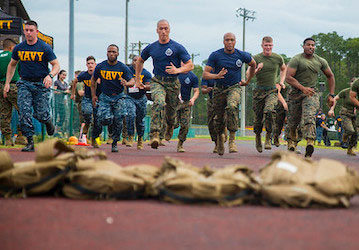Physical fitness is a key component of military fitness, general health, and well-being. It’s often seen as the most important priority for deployability and performance optimization. While it is true that physical fitness is a big piece of the fitness puzzle, it is not the only piece to being a healthy, high-performing Service Member.
Physical fitness for health and performance
Being physically fit, in particular being fit cardiovascularly, reduces your risk for chronic diseases such as heart disease, obesity, diabetes, and cancer. This reduces your risk for premature death–that is, dying before the age of 75. This is especially important for people who sit for 8 + hours a day, which increases the risk of premature death. This is best offset by doing at least 150 minutes of physical activity every week.
Being physical fit reduces your risk of injury during work and sports, in addition to helping prevent disease. Injuries to muscles, bones, tendons, and ligaments are the number one cause of lost-duty time in the military. Most injuries happen during physical training and recreational sports. Consistent training to maintain cardiorespiratory fitness, muscular strength, and endurance can help keep your fitness up. Training for neuromuscular control can do the leg work to keep your risk down.

Total Force Fitness
While physical fitness is a domain of TFF that touches other domains in some way, it shouldn’t be seen as the “central” domain. There is much more that goes into deployability and readiness than physical fitness. Here’s how physical fitness interacts with each of the other domains.
Performance nutrition
Proper nutrition is the backbone of any physical fitness program. When viewing nutrition and physical fitness from a health perspective, a good diet plan is essential for weight management. The basic formula for weight loss is “calories in is less than calories out.” Exercise only accounts for a couple hundred calories per session at most. It’s important to keep track of the calories you eat and drink because you can’t outrun a poor diet.
From a performance perspective, proper macronutrient distributions, and nutrient timing can promote recovery and support muscle mass gains. This is where exercise best supports weight management—in the long term. As you increase lean muscle mass and reduce fat mass, you can increase your resting metabolism. You then need to burn more calories to support your bigger muscles. You still need to keep track of your calories while you do resistance training to build muscle mass. Even though you need more calories to maintain muscle mass, you can still overeat what you need to maintain your lean body composition. You also can’t out lift a poor diet.
Mental fitness
Mental fitness and physical fitness go hand-in-hand to support both health and performance. Meeting, or exceeding, the 150-minute weekly physical activity milestone supports mental health in many ways. It can prevent both depression and anxiety, as well as help manage symptoms for people with those conditions. Regular physical activity also improves cognition, or your ability to learn and retain information. This is especially important for Service Members in training environments, school-age children, and older adults, to prevent age-related memory loss.
Mental performance optimization skills, such as goal setting, mindfulness, and positive self-talk, support physical performance. They help keep you focused on the task at hand, rather than stressing about past or future events, and keep you motivated throughout the task.
Teamwork, relationships, and communication
Physical activity is a great way to improve and maintain social fitness. Participation in group activities, such as competitive sports with your co-workers, can help improve teamwork and communication skills. Even “individual” sports, such as martial arts, tennis, or golf, require a partner and can be used to foster relationships. There’s a reason business is often done of a golf course.
Within family units, being active together helps keep kids engaged and can improve a family bond. Additionally, parental support for kids’ activities, like group sports, keeps them motivate to participate, which can go a long way to staying fit, improving cognitive skills, and fighting childhood obesity.
Physical fitness should be seen as a touchpoint for the other domains of TFF, rather than the focus of health and performance. While it is important for the physical aspects of your job, it is impossible to optimize your physical performance without incorporating the other TFF domains.
